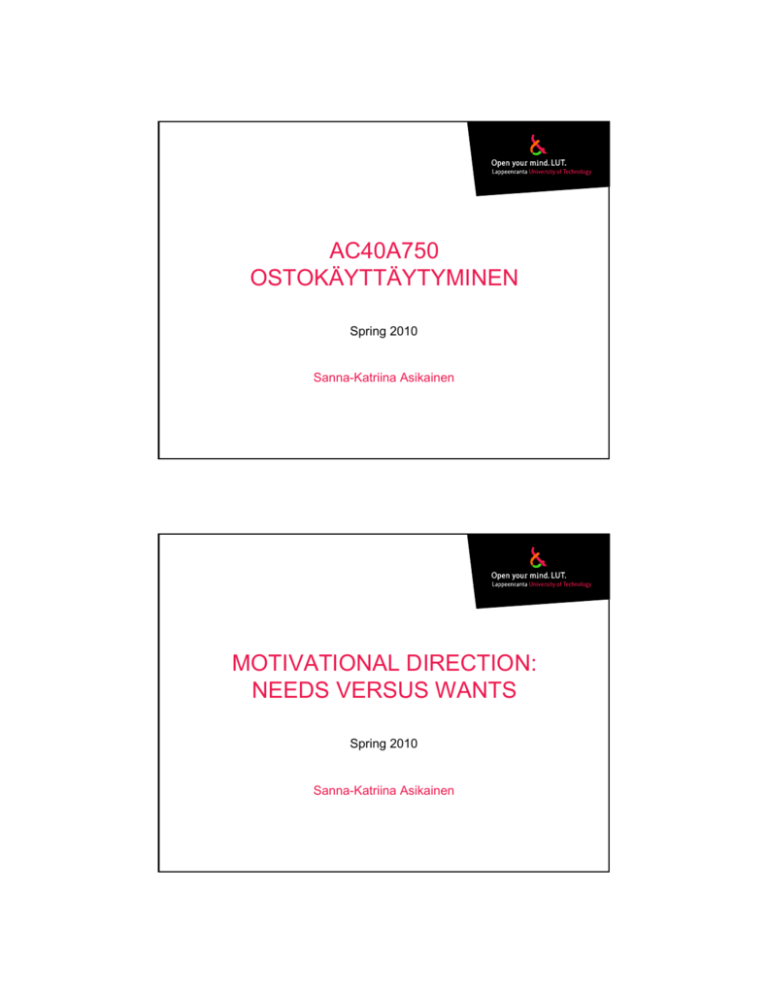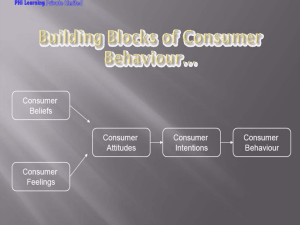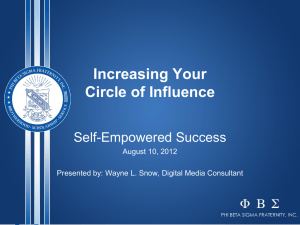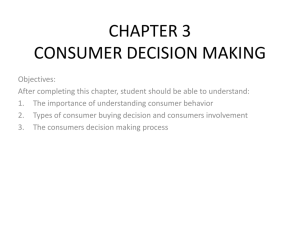needs versus wants
advertisement

AC40A750 OSTOKÄYTTÄYTYMINEN Spring 2010 Sanna-Katriina Asikainen MOTIVATIONAL DIRECTION: NEEDS VERSUS WANTS Spring 2010 Sanna-Katriina Asikainen CONSUMER NEEDS AND MARKETING − Marketing students are taught from day one that the goal of marketing is to satisfy consumers’ needs. − However, this insight is useless unless we can discover what those needs are and why they exist. NEEDS VERSUS WANTS DO MARKETERS CREATE ARTIFICIAL NEEDS? Objective of marketing: create awareness that needs exist, not to create needs − Need: a basic biological motive versus − Want: one way that society has taught us that the need can be satisfied TYPES OF NEEDS Types of needs: − Innate versus learned − Biogenic versus psychogenic − Biogenic: biological needs, such as for air, water, food − Psychogenic: need for status, power, affiliation − Utilitarian versus hedonic: − Utilitarian: need for tangible attributes of a product, such as miles per gallon in a car or calories in a cheeseburger − Hedonic: needs for excitement, self-confidence, fantasy − Sociogenic: desires SPECIFIC NEEDS AND BUYER BEHAVIOR NEED FOR ACHIEVEMENT NEED FOR AFFILIATION Value personal accomplishment Place a premium on products that signify success (luxury brands, technology products) Want to be with other people Focus on products that are used in groups (alcoholic beverages, sports bars) NEED FOR POWER NEED FOR UNIQUENESS Control one’s environment Focus on products that allow them to have mastery over surroundings (muscle cars, loud boom-boxes) Assert one’s individual identity Enjoy products that focus on their unique character (perfumes, clothing) LEVELS OF NEEDS IN THE MASLOW HIERARCHY DESIRE − is more than a want, and it is certainly more than a need − is more than an emotion, and it is certainly more than a mood − is a motivation of the most intense kind − is an emoting involving a passion attached to an object − a product, a person, a cause, a life goal − emphasizes that, even though desires, needs, and wants are felt psychologically, the concept of society is very central to understanding of desire − sociogenic need − works on the pleasure principle − we have desires because we seek pleasure MOTIVATION PROCESS − Motivation: process that leads people to behave as they do − Also, the forces that drive us to buy/use products − Goal: consumer’s desired end state − Drive: degree of consumer arousal − Want: manifestation of consumer need − The ad shows desired state and suggests solution (purchase of equipment) × Click image for www.soloflex.com A MODEL OF CONSUMER MOTIVATION DESIRED STATE ACTUAL STATE TENSION (Felt discomfort) DRIVE (Energy) GOAL OBJECT (Something that will reduce the tension) MOTIVATIONAL STRENGTH Motivational strength: degree of willingness to expend energy to reach a goal − Drive theory: biological needs that produce unpleasant states of arousal (e.g., hunger) − Expectancy theory: behavior is pulled by expectations of achieving desirable outcomes MOTIVATIONAL CONFLICTS × Click image for www.drugfree.org − Goal valence (value): consumer will: − Approach positive goal − Avoid negative goal − Example: Partnership for a Drug-Free America communicates negative consequences of drug addiction for those tempted to start THREE TYPES OF MOTIVATIONAL CONFLICTS • Two desirable alternatives • Cognitive dissonance • Positive & negative aspects of desired product • Guilt of desire occurs • Facing a choice with two undesirable alternatives INVOLVEMENT Spring 2010 Sanna-Katriina Asikainen CONSUMER INVOLVEMENT − Involvement: − perceived relevance of an object based on one’s needs, values, and interests − Involvement can be viewed as motivation to process information. − Different levels of involvement: − High-involvement: Passion − Low-involvement: Inertia, decisions made out of habit (lack of motivation) − In most cases, consumer’s level of involvement falls in the middle. − Many faces of involvement: − Cognitive − Emotional THE MANY FACES OF INVOLVEMENT − Product Involvement: − Related to a consumer’s level of interest in a particular product − Message-Response Involvement: − (a.k.a. advertising involvement) Refers to a consumer’s interest in processing marketing communications − Purchase Situation Involvement: − Refers to the differences that may occur when buying the same product for different contexts CONCEPTUALIZING INVOLVEMENT MEASURING INVOLVEMENT − Teasing out the Dimensions of Involvement: − Involvement Profile (Laurent & Kapferer): − Personal interest in a product category − Risk importance − Probability of making a bad purchase − Pleasure value of the product category − How closely the product is related to the self − Zaichkowsky’s Personal Involvement Inventory Scale − Segmenting by Involvement Levels: − Involvement is a useful basis for market segmentation MEASURING INVOLVEMENT: INVOLVEMENT SCALE To me (object to be judged) is: 1. important _:_:_:_:_:_:_ unimportant 2. boring _:_:_:_:_:_:_ interesting 3. relevant _:_:_:_:_:_:_ irrelevant 4. exciting _:_:_:_:_:_:_ unexciting 5. means nothing _:_:_:_:_:_:_ means a lot 6. appealing _:_:_:_:_:_:_ unappealing 7. fascinating _:_:_:_:_:_:_ mundane 8. worthless _:_:_:_:_:_:_ valuable 9. involving _:_:_:_:_:_:_ uninvolving 10. not needed _:_:_:_:_:_:_ needed DIMENSION OF INVOLVEMENT The amount of consumer involvement depends on: − Personal interest in product category − Risk importance − Probability of bad purchase − Pleasure value of product category − Sign value of product category (self-concept relevance) STRATEGIES TO INCREASE INVOLVEMENT − Appeal to hedonistic needs − Use novel stimuli in commercials − Use prominent stimuli in commercials − Include celebrity endorsers in commercials − Build consumer bonds via ongoing consumer relationships ATTITUDES Spring 2010 Sanna-Katriina Asikainen INTENDED LEARNING OUTCOMES When you finish this chapter you should understand why: − It’s important for consumer researchers to understand the nature and power of attitudes. − Attitudes are more complex than they first appear. − We form attitudes in several ways. − A need to maintain consistency among all of our attitudinal components motivates us to alter one or more of them. − We use attitude models to identify specific components and combine them to predict a consumer’s overall attitude toward a product or brand. THE POWER OF ATTITUDES − Attitude: a lasting, general evaluation of people, objects, advertisements, or issues − Attitude object (AO) − Help to determine a number of preferences and actions − Consumers have attitudes towards very productspecific behaviors as well as towards more general consumption-related behaviours FUNCTIONAL THEORY OF ATTITUDES − Katz: attitudes exist because they serve some function UTILITARIAN FUNCTION: VALUE-EXPRESSIVE FUNCTION: Relates to rewards and punishments Expresses consumer’s values or self-concept EGO-DEFENSIVE FUNCTION: Protect ourselves from external threats or internal feelings KNOWLEDGE FUNCTION: Need for order, structure, or meaning − An attitude can serve more than one function but in many cases a particular one will be dominant. ABC MODEL OF ATTITUDES Attitude has three components: − Affect: the way a consumer feels about an attitude object. − Behavior: person’s intentions to do something with regard to an attitude object. − Cognition: beliefs a consumer has about an attitude object. HIERARCHIES OF EFFECTS − Impact/importance of attitude components depends on consumer’s motivation toward attitude object HIERARCHY OF EFFECTS − Standard Learning Hierarchy − Results in strong brand loyalty − Assumes high consumer involvement − Low-Involvement Hierarchy − Consumer does not have strong brand preference − Consumers swayed by simple stimulus-response connections − Experiential Hierarchy − Consumers’ hedonic motivations and moods − Emotional contagion − Cognitive-affective model versus independence hypothesis FORMING ATTITUDES − An attitude can form in several different ways, depending on the particular hierarchy of effects in operation. E.g. via: − classical conditioning − wherein an attitude object such as the name Pepsi is repeatedly paired with a catchy jingle − instrumental conditioning − in which consumption of the attitude object is reinforced. − complex cognitive process − E.g. a teenager may come to model the behavior of friends and media figures who drink Pepsi because she belives that this act will enable her to fit in with the desirable images of the Pepsi Generation. ATTITUDE COMMITMENT Degree of commitment is related to level of involvement with attitude object INTERNALIZATION Highest level: deep-seeded attitudes become part of consumer’s value system IDENTIFICATION Mid-level: attitudes formed in order to conform to another person or group COMPLIANCE Lowest level: consumer forms attitude because it gains rewards or avoids punishments CONSISTENCY PRINCIPLE Principle of cognitive consistency: − We value/seek harmony among thoughts, feelings, and behaviors − We will change components to make them consistent − Cognitive dissonance − Self-perception theory − Social judgement theory − Balance theory COGNITIVE DISSONANCE AND HARMONY − Theory of cognitive dissonance: when a consumer is confronted with inconsistencies among attitudes or behaviors, he will take action to resolve the “dissonance” − Example: Two cognitive elements about smoking: − “I know smoking causes cancer” − “I smoke cigarettes” − Consumer will resolve the dissonance by either satisfying urge to smoke or stopping the behavior SELF PERCEPTION THEORY − Self-perception theory: we use observations of our own behavior to determine what our attitudes are. FOOT-IN-THE-DOOR TECHNIQUE Consumer is more likely to comply with a request if he has first agreed to comply with a smaller request LOW-BALL TECHNIQUE Person is asked for a small favor and is informed after agreeing to it that it will be very costly. DOOR-IN-THE-FACE TECHNIQUE Person is first asked to do something extreme (which he refuses), then asked to do something smaller. SOCIAL JUDGEMENT THEORY − Social judgment theory: we assimilate new information about attitude objects in light of what we already know/feel − Initial attitude = frame of reference − Latitudes of acceptance and rejection − Assimilation and contrast effects − As a person becomes more involved with an attitude object, his or her latitude of acceptance shrinks. BALANCE THEORY − Balance theory: considers relations among elements a consumer might perceive as belonging together − Involves triad attitude structures: − Person − Perception of attitude object − Perception of other person/object − Perception can be positive or negative − Balanced/harmonious triad elements − Unit relation and sentiment relation RESTORING BALANCE IN A TRIAD − Alex wants to date Larry; Alex has positive sentiment toward Larry − Larry wears earring; Larry has positive attitude toward earring − Alex doesn’t like men who wear earrings; has negative sentiment toward earrings MULTI-ATTRIBUTE ATTITUDE MODELS − Multi-attribute models: consumer’s attitudes toward an attitude object depends on beliefs she has about several or many attributes of the object − Three elements − Attributes of AO (e.g., college) − Example: scholarly reputation − Beliefs about AO − Example: Lappeenranta School of Business is strong academically − Importance weights − Example: stresses research over athletics FISHBEIN MODEL − Measures three components of attitudes: − Salient beliefs about AO − Object-attribute linkages − Evaluation of each important attribute − Aijk = ΣBijkIik − Overall Attitude Score = (consumer’s rating of each attribute for all brands) x (importance rating for that attribute) SAUNDRA’S COLLEGE DECISION Beliefs (β) Attribute Import (I) Smith Princeton Rutgers Northlan d Academic reputation 6 8 9 6 3 All women 7 9 3 3 3 Cost 4 2 2 6 9 Proximity to home 3 2 2 6 9 Athletics 1 1 2 5 1 Party atmosphere 2 1 3 7 9 Library facilities 5 7 9 7 2 163 142 153 131 Attitude Score AN EXAMPLE OF THE ORIGINAL FISHBEIN ATTITUDE MODEL − Mitä seuraavista automalleista Mercedes SLK, Porsche 911, Corvette kohtaan esimerkin vastaajilla on positiivisimmat asenteet? − Entä negatiivisimmat? − Mitä tämä tarkoittaa markkinoijan näkökulmasta? ATTRIBUTES Attribute: 1 Sporty Styling 2 Good Handling/Ride 3 High Cost 4 Great Acceleration 5 Low Repair Frequency EVALUATION OF THE ATTRIBUTE AS BEING GOOD OR BAD Extremely Good +3 Moderately Good +2 Neither Good Slightly nor Slightly Moderately Good Bad Bad Bad +1 0 -1 -2 Attribute Sporty Styling Good Handling/Ride High Cost Great Acceleration Low Repair Frequency Extremely Bad -3 Rating (ei) +3 +3 -1 +3 +1 BELIEF ABOUT THE BRAND’S POSSESSION OF THE ATTRIBUTE Extremely Likely +3 Moderately Likely +2 Attribute Sporty Styling Good Handling/Ride High Cost Great Acceleration Low Repair Frequency Neither Likely Slightly nor Likely Unlikely +1 0 Mercedes SLK +3 +2 +3 +1 -1 Slightly Unlikely -1 Porsche 911 +3 +3 +3 +3 -2 Moderately Unlikely -2 Extremely Unlikely -3 Corvette +2 +2 +2 +2 +2 MARKETING APPLICATIONS OF MULTI-ATTRIBUTE MODE − Capitalize on relative advantage: convince consumers that particular product attributes are important in brand choice − Strengthen perceived product/attribute linkages: if consumers don’t associate certain attributes with the brand, make the relationship stronger − Add a new attribute: focus on unique positive attribute that consumer has not considered − Influence competitors’ ratings: decrease the attributes of competitors EXTENDED FISHBEIN MODEL Theory of reasoned action: considers other elements of predicting behavior − Intentions versus behavior: measure behavioral intentions, not just intentions − Social pressure: acknowledge the power of other people in purchasing decision − Attitude toward buying: measure attitude toward the act of buying, not just the product THEORY OF REASONED ACTION OBSTACLES TO PREDICTING BEHAVIOR Fishbein model’s weaknesses include: − Doesn’t deal with outcomes of behavior, including those beyond consumer’s control − Doesn’t consider unintentional behavior, such as impulsive acts or novelty seeking − Doesn’t consider that attitudes may not lead to consumption − Doesn’t consider the time frame between attitude measurement and behavior − Doesn’t differentiate between consumer’s direct, personal experience, and indirect experience CONSUMER AS A DECISION MAKER Spring 2010 Sanna-Katriina Asikainen INTENDED LEARNING OUTCOMES When you finish this chapter you should understand why: − Consumer decision making is a central part of consumer behavior, but the way we evaluate and choose products (and the amount of thought we put into these choices) varies widely, depending upon such dimensions as the degree of novelty or risk in the decision. − A decision is actually composed of a series of stages that results in the selection of one product over competing options. − Decision making is not always rational. − Consumers rely upon different decision rules when evaluating competing options. − We often fall back on well learned “rules-of-thumb” to make decisions. CONSUMERS AS PROBLEM SOLVERS − Consumer purchase = response to problem − After realization that we want to make a purchase, we go through a series of steps in order to make it − Can seem automatic or like a full-time job − Complicated by consumer hyperchoice − Decision-making process DECISION MAKING PROCESS DECISION MAKING PERSPECTIVES − Rational perspective: consumers: − Integrate as much information as possible with what they already know about a product − Weigh pluses and minuses of each alternative − Arrive at a satisfactory decision DECISION MAKING PERSPECTIVES − Other models of decision making: − Purchase momentum: − occurs when consumers buy beyond needs satisfaction − Behavioral influence perspective: − consumers buy based on environmental cues, such as a sale − Experiential perspective: − consumers buy based on totality of product’s appeal CONTINUUM OF BUYING DECISION BEHAVIOR TYPES OF CONSUMER DECISIONS − Extended problem solving: − Initiated by a motive that is central to self-concept − Consumer feels that eventual decision carries a fair degree of risk − Limited problem solving: − Buyers not as motivated to search for information or to evaluate rigorously − Buyers use simple decision rules to choose − Habitual decision making: − Choices made with little to no conscious effort STAGE 1: PROBLEM RECOGNITION Occurs when consumer sees difference between current state and ideal state − Need recognition: actual state moves downward − Opportunity recognition: ideal state moves upward Marketers can create: − Primary demand: encourage consumers to use product category − Secondary demand: persuade consumers to use specific brand PROBLEM RECOGNITION: SHIFTS IN ACTUAL OR IDEAL STATES STAGE 2: INFORMATION SEARCH − Information search: process by which consumer surveys the environment for appropriate data to make reasonable decision Prepurchase versus Ongoing Search Prepurchase Search Ongoing Search Determinants Involvement with purchase Involvement with product Motives Making better purchase decisions Building a bank of information for future use Outcomes Better purchase decisions Increased impulse buying INTERNAL VERSUS EXTERNAL SEARCH − Internal search − Scanning memory to assemble product alternative information − External search − Obtaining information from ads, retailers, catalogs, friends, family, people-watching, Web sites DELIBERATE VERSUS ”ACCIDENTAL” SEARCH × Click photo for Consumerreports.org − Directed learning: existing product knowledge obtained from previous information search or experience of alternatives − Incidental learning: mere exposure over time to conditioned stimuli and observations of others THE ECONOMICS OF INFORMATION − Consumers will gather as much data as needed to make informed decisions − We will collect most valuable information first − Variety seeking: desire to choose new alternatives over more familiar ones DO CONSUMERS ALWAYS SEARCH RATIONALLY? − Some consumers avoid external search, especially with minimal time to do so and with durable goods (e.g. autos) − Symbolic items require more external search − Brand switching: we select familiar brands when decision situation is ambiguous − Variety seeking: desire to choose new alternatives over more familiar ones AMOUNT OF INFORMATION SEARCH AND PRODUCT KNOWLEDGE PERCEIVED RISK − Perceived risk: belief that product has negative consequences − Expensive, complex, hard-tounderstand products − Product choice is visible to others (risk of embarrassment for wrong choice) − Risks can be objective (physical danger) and subjective (social embarrassment) FIVE TYPES OF PERCEIVED RISKS DISCUSSION − Choosing a brand/product among available alternatives requires much of the effort that goes into a purchase decision. − Which is the greater problem for a consumer: − Not having enough choices or having too many choices? − Why? STAGE 3: EVALUATION OF ALTERNATIVES − To arrive a choice, consumer needs two things: − Evaluation criteria − Judgement models − Evaluation criteria are standards against which consumers evaluate a product − Judgement models (a.k.a. decision models, choice rules) are procedures and rules consumers use so as to consider various product attributes to arrive at their product choice. IDENTIFYING ALTERNATIVES − Extended problem solving = evaluation of several brands − Occurs when choice conflicts arouse negative emotions (involving difficult trade-offs) − Habitual decision = consider few/no brand alternatives IDENTIFYING ALTERNATIVES − Evoked set versus consideration set − We usually don’t seriously consider every brand we know about. − In fact, we often include only a surprisingly small number of alternatives in our evoked set. − Marketers must focus on getting their brands in consumers’ evoked set. − We often do not give rejected brands a second chance. CATEGORIZING PRODUCTS − We evaluate products in terms of what we already know about a (similar) product. − Evoked-set products usually share similar features − When faced with a new product, we refer to existing product category knowledge to form new knowledge. − Marketers want to ensure that their products are correctly grouped in knowledge structures. LEVELS OF CATEGORIZATION STRATEGIC IMPLICATIONS OF PRODUCT CATEGORIZATION − Product positioning − Convincing consumers that product should be considered within a given category − Identifying competitors − Products/services different on the surface can actually compete on superordinate level for consumer dollars STRATEGIC IMPLICATIONS OF PRODUCT CATEGORIZATION − Exemplar products − Brands strongly associated with a category “call the shots” by defining evaluative criteria − But “moderately unusual” products stimulate more information processing and positive evaluations − Locating products − Products that do not fit clearly into categories confuse consumers (e.g., frozen dog food) PRODUCT CHOICE − Selecting among alternatives − Once we assemble and evaluate relevant options from a category, we must choose among them − Decision rules for product choice can be very simple or very complicated − Prior experience with (similar) product − Present information at time of purchase − Beliefs about brands (from advertising) EVALUATIVE CRITERIA − Evaluative criteria: dimensions used to judge merits of competing options − Determinant attributes: features we use to differentiate among our choices − Criteria on which products differ carry more weight − Marketers educate consumers about (or even invent) determinant attributes EVALUATIVE CRITERIA − Procedural learning: cognitive steps before making choice − Marketers often point out significant differences among brands on relevant attribute… − Then supply consumers with decision-making rule (“if, then”) that has helped them make previous decisions NEUROMARKETING − Neuromarketing: uses functional magnetic resonance imaging, a brain-scanning device that tracks blood flow as we perform mental tasks − Marketers measure consumers’ reactions to movie trailers, choices about automobiles, the appeal of a pretty face, and loyalty to specific brands HEURISTICS: MENTAL SHORTCUTS − Heuristics: mental rules-ofthumb that lead to a speedy decision − Examples: higher price = higher quality, buying the same brand your mother bought − Can lead to bad decisions due to flawed assumptions (especially with unusually named brands) × Click photo for iparty.com RELYING ON A PRODUCT SIGNAL − Product signal: observable product attributes that communicate underlying qualities − Clean and shiny car = good mechanical condition − Covariation: perceived associations among events − Product type/quality and country of origin − Consumers are poor estimators of covariation (selffulfilling prophecy: we see what we are looking for) MARKET BELIEFS − Consumer assumptions about companies, products, and stores that become shortcuts for decisions − Price-quality relationship: we tend to get what we pay for − Other common marketing beliefs − All brands are basically the same − Larger stores offer better prices than smaller stores − Items tied to “giveaways” are not a good value COUNTRY OF ORIGIN − We rate our own country’s products more favorably than do people who live elsewhere − Industrialized countries make better products than developing countries − Attachment to own versus other cultures − Nationalists − Internationalists − Disengaged CHOOSING FAMILIAR BRAND NAMES − Zipf’s Law: our tendency to prefer a number one brand to the competition − Brands that dominate the market are sometimes 50% more profitable than their nearest competitors − Consumer inertia: the tendency to buy a brand out of habit merely because it requires less effort − Brand loyalty: repeat purchasing behavior that reflects a conscious decision to continue buying the same brand HYPOTHETICAL ALTERNATIVES FOR A TV SET Brand Ratings Attribute Importance Ranking Prime Wave Precision Kamashita Excellent Size of screen 1 Excellent Excellent Stereo broadcast capability 2 Poor Excellent Brand reputation 3 Excellent Excellent Poor Onscreen programming 4 Excellent Poor Poor Cable-ready capability 5 Good Good Good Sleep timer 6 Excellent Poor good DECISION RULES − Noncompensatory decision rules when we feel that a product with a low standing on one attribute can’t compensate for this flaw by doing better on another attribute − Types of noncompensatory decision rules: − Lexicographic rule, consumers select the brand that is the best on the most important attribute − Elimination-by-aspects rule: the buyer also evaluates brands on the most important attribute − Conjunctive rule: entails processing by brand DECISION RULES − Compensatory decision rules: give a product a chance to make up for its shortcomings − Types of compensatory decision rules: − Simple additive rule: the consumer merely chooses the alternative that has the largest number of positive attributes − Weighted additive rule: the consumer also takes into account the relative importance of positively rated attributes, essentially multiplying brand ratings by importance weights









